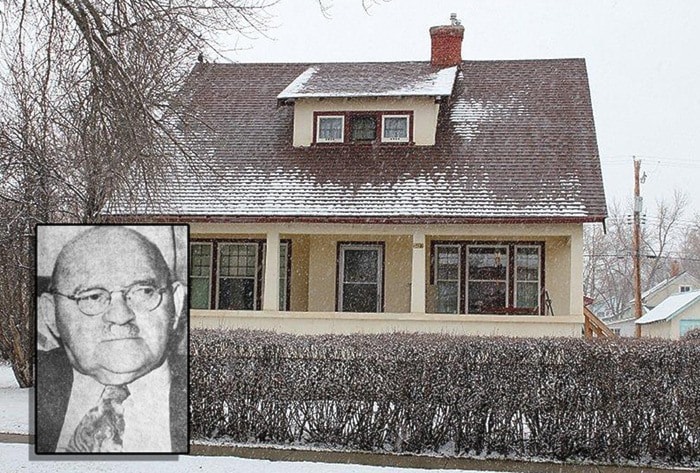There is absolutely no doubt that all facets of our medical profession is extremely stressed on a torrid 24-7 basis these days, but just for an interesting comparison let us take a look back to when our Ponoka became a new and thriving town in 1904.
With the town and country districts growing at a rapid pace, many vital needs arose, and a few hardy physicians would soon arrive at the Canadian Pacific Railway Station (originally Siding 14) and began to set up their humble practises and would faithfully serve the early medical needs of young and old alike, quite often by horse and buggy.
They often performed ‘medical miracles’
Dr. A. A. Drinnan was the very first Doctor of the bustling Village of Ponoka, arriving in 1902 to set up his practise and eventually build his palatial home and fox farm on the shores of the magnificent Chain Lakes south east of the soon to be a town. After a short stay in Saskatchewan and service in the First World War he returned to Ponoka to faithfully serve his patients for many years, and then retired to live with his family on the farm until his death. An Englishman, Dr. W.A. Campbell would put up his shingle here in 1903, later practising out of the Baadsgard Building on Chipman Avenue, where he also went into partnership with his brother in the town’s first drug store and would serve the community until his death in 1934. Other Physicians answering the call for medical care and healing in the new town were Drs. T.B. Stevenson, J.F. Brander, and David Bell.
The ‘kitchen table’ surgeon
In 1912 Dr. Melvin Graham, a graduate of the Toronto University Medical School arrived in Ponoka with his new bride directly from London, England, where he had completed a year of graduate studies, which also included a course in eye refraction and diseases of the eyes. Once settled in town Dr. Graham opened an office on Donald Avenue (51st), and then in 1922 moved to his new palatial home just a few doors down, which would also become a big part of his active practise, which he faithfully served until his death in 1962.
Over his many years of dedication to the community Dr. Graham loved to relate countless vivid and colourful stories of the trials, tribulations, and adventures of early medical procedures and practises in and around the vast town and county of Ponoka. He fondly recalled doing appendix operations, amputations, and other emergency procedures and treatment by the light of a flickering coal oil lamp on his kitchen table, with the most urgent order being ‘please boil some water now.’ The friendly doctor always strongly believed that most of those patients would recover because the hardy settlers of those days were the strong and sturdy type and were hard to kill. If the docs couldn’t make it to an emergency call the ladies of the town or district would always respond to assist their ailing neighbours, as well as delivering many babies, while the men were always ready to help wherever they were needed. Dr. Graham, who loved his work and never voiced any regrets along the way also remembered the horrific ‘flu epidemic of 1918’, when the Town Hall was used in the emergency, and every person who wasn’t sick was very willing to become an instant nurse or a cook. To assist our early doctors, nursing homes and recovery rooms were set up around the community, with kindly assistance provided to hundreds of patients by the trained nurses and ladies from their homes until the early 1940s.
The amazing history of town and county could not be written without the mention of a great deal of recognition and gratitude paid to the sheer courage and stamina of our early doctors, namely Drinnan, Campbell, Graham, S.J. and J.N.C. Byers in Rimbey, Dr. Haynes in Lacombe, and on and on through many gruelling decades of growth, progress, and challenges. These faithful Physicians and emergency personnel answered calls at all hours from near and far, responded in all kinds of weather, floods, bugs and often rough and tumble roads. When their horses were exhausted or their cars broke down or got stuck they would somehow always find another way to get to their destination. Depending on the state of the economy the pay for their dedicated services may have been a few dollars, but more than likely would be a sack of potatoes, a chicken, a cabbage, or whatever, but in all cases they would always receive the thankful hospitality of a home cooked meal or a warm bed if they couldn’t get back home.
During the First World War the only hospitals in the area were located in Lacombe, Wetaskiwin, and Edmonton, with the St. Paul’s Hospital in Rimbey being completed in the late 1920s, which later became a convalescent facility. After the Second World War exciting and vital milestones of our Ponoka health care community came with the opening of our first municipal hospital in 1945, which was also complimented by the arrival of many new physicians, nursing staff, professionals, and facilities such as the first Medical Centre in 1963, all of which that would serve ongoing the medical and emergencies needs of our growing urban and rural communities.
This grand and long-standing vital tradition of compassionate care and healing has and will always be a blessing for families and individuals of all ages and walks of life in our vibrant Town and County of Ponoka.
